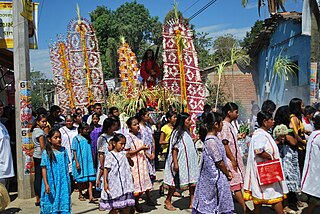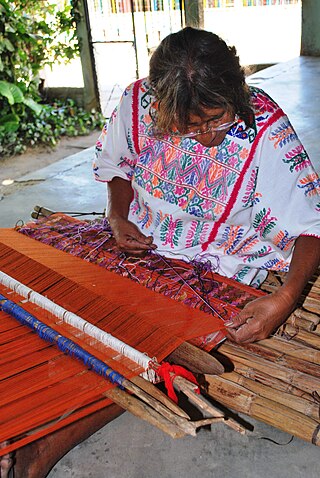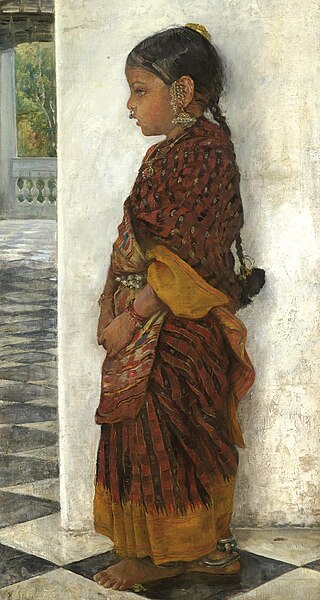This article needs additional citations for verification .(May 2009) |
East Timor Women Australia (ETWA) is a grassroots non-government organisation established to support women in East Timor.
This article needs additional citations for verification .(May 2009) |
East Timor Women Australia (ETWA) is a grassroots non-government organisation established to support women in East Timor.
A key focus of support is in assisting women's sustainable livelihoods in the handcrafts industry. ETWA partners with local organisations the Taibesi Cooperative and Cooperativa Tais Timor (CTT). These organisations source tais, the traditional East Timorese weavings, from rural and urban weaving groups. The weaving of tais requires a great deal of skill with designs having a deeply embedded cultural meaning. Designs are passed down from mother to daughter with great variation across the country.
Tais are woven on back-strap looms where a harness sits on the lower back providing tension. Traditionally tais were made from locally sourced and spun cotton although many weavers have incorporated imported cotton into their designs. Many East Timorese organisations such as CTT and Taibesi are also incorporating tais into other product design in order to access broader markets for their products.
ETWA supports the handcrafts industry as a mechanism which allows women to support themselves while maintaining their cultural heritage. With high rates of domestic violence in East Timor economic empowerment may be one way to further strengthen women's social role and opportunities.[ citation needed ] It also allows the many women widowed or orphaned under the Indonesian occupation with a means of supporting themselves while recognising their highly specialised skills and expertise.
ETWA is a member-based organisation that is run by volunteers with support by a part-time coordinator. It was established in 2004 by a group of community development students, some of whom were active in the Free East Timor movement before the 1999 referendum. As well as its Melbourne based office ETWA also has chapters active in the Dandenong Ranges, Gippsland and the Northern Territory. The organisation is self-funded by membership fees, donations and fundraising activities.
In addition to supporting CTT and the Taibesi Cooperative to find markets overseas ETWA undertakes other activities. Currently these include developing a program for social justice education in schools, a design collaboration with students from the University of New South Wales and community advocacy. In 2005 ETWA cooperated with the Royal Melbourne Institute of Technology Globalism Institute to hold the Challenges and Possibilities Archived 12 September 2006 at the Wayback Machine conference which facilitated dialogue between organisations working with women in East Timor. In 2007 ETWA will support a health study into the health of Timorese weavers. The organisation also has a very strong relationship with the Dili-based Cooperative Studies Centre.
ETWA is cited in the book Reluctant Saviour by activist-historian Clinton Fernandes as an example of positive collaboration for sustainable development in East Timor.

Weaving is a method of textile production in which two distinct sets of yarns or threads are interlaced at right angles to form a fabric or cloth. Other methods are knitting, crocheting, felting, and braiding or plaiting. The longitudinal threads are called the warp and the lateral threads are the weft, woof, or filling. The method in which these threads are interwoven affects the characteristics of the cloth. Cloth is usually woven on a loom, a device that holds the warp threads in place while filling threads are woven through them. A fabric band that meets this definition of cloth can also be made using other methods, including tablet weaving, back strap loom, or other techniques that can be done without looms.

Jamdani is a fine muslin textile produced for centuries in South Rupshi of Narayanganj district in Bangladesh on the bank of Shitalakhwa river.

A Banarasi sari is a sari made in Varanasi, an ancient city which is also called Benares (Banaras). The saris are among the finest saris in India and are known for their gold and silver brocade or zari, fine silk and opulent embroidery. The saris are made of finely woven silk and are decorated with intricate designs, and, because of these engravings, are relatively heavy.
Maya textiles (k’apak) are the clothing and other textile arts of the Maya peoples, indigenous peoples of the Yucatán Peninsula in Mexico, Guatemala, Honduras, El Salvador and Belize. Women have traditionally created textiles in Maya society, and textiles were a significant form of ancient Maya art and religious beliefs. They were considered a prestige good that would distinguish the commoners from the elite. According to Brumfiel, some of the earliest weaving found in Mesoamerica can date back to around 1000-800 B.C.E.

Tais is a form of Tenun weaving tradition native to the eastern Indonesian regions of the Maluku Islands, the Tanimbar Islands, and the East Nusa Tenggara Islands. It has become an essential part of people in the eastern Indonesia hemisphere region, which mainly used for ceremonial adornment, sign of respect and appreciation towards guests, friends, relatives, home decor, and personal apparel.

Xochistlahuaca is a town in Xochistlahuaca Municipality located in the southeast corner of the Mexican state of Guerrero. It is part of this state's Costa Chica region and while near the Pacific Ocean, most of the territory is mountainous. The population is dominated by the indigenous Amuzgo ethnicity, whose women are noted for their traditional hand woven garments, especially the huipil, which is made both for home use and for sale outside the area.
The Bhutan Textile Museum or the National Textile Museum is a national textiles museum in Thimphu, Bhutan, located near the National Library of Bhutan. It is operated by the National Commission for Cultural Affairs. Since its establishment in 2001, the museum has generated national and international attention and has garnered a substantial collection of antique textile artefacts, exclusive to Bhutan.

The textiles of Mexico have a long history. The making of fibers, cloth and other textile goods has existed in the country since at least 1400 BCE. Fibers used during the pre-Hispanic period included those from the yucca, palm and maguey plants as well as the use of cotton in the hot lowlands of the south. After the Spanish conquest of the Aztec Empire, the Spanish introduced new fibers such as silk and wool as well as the European foot treadle loom. Clothing styles also changed radically. Fabric was produced exclusively in workshops or in the home until the era of Porfirio Díaz, when the mechanization of weaving was introduced, mostly by the French. Today, fabric, clothes and other textiles are both made by craftsmen and in factories. Handcrafted goods include pre-Hispanic clothing such as huipils and sarapes, which are often embroidered. Clothing, rugs and more are made with natural and naturally dyed fibers. Most handcrafts are produced by indigenous people, whose communities are concentrated in the center and south of the country in states such as Mexico State, Oaxaca and Chiapas. The textile industry remains important to the economy of Mexico although it has suffered a setback due to competition by cheaper goods produced in countries such as China, India and Vietnam.
Awamaki is a non-profit with a stated goal of creating economic opportunities and uplifting social well-being in rural Peru. It is registered in the United States as a 501(c)(3) and in Peru as a non-profit civil association. Awamaki is diversified and currently provides programs in health, education, cultural preservation and sustainable tourism.

Amuzgo textiles are those created by the Amuzgo indigenous people who live in the Mexican states of Guerrero and Oaxaca. The history of this craft extends to the pre-Columbian period, which much preserved, as many Amuzgos, especially in Xochistlahuaca, still wear traditional clothing. However, the introduction of cheap commercial cloth has put the craft in danger as hand woven cloth with elaborate designs cannot compete as material for regular clothing. Since the 20th century, the Amuzgo weavers have mostly made cloth for family use, but they have also been developing specialty markets, such as to collectors and tourists for their product.

The Amuzgos are an indigenous people of Mexico. They primarily live in a region along the Guerrero/Oaxaca border, chiefly in and around four municipalities: Xochistlahuaca, Tlacoachistlahuaca and Ometepec in Guerrero, and San Pedro Amuzgos in Oaxaca. Their languages are similar to those of the Mixtec, and their territories overlap. They once dominated a larger area, from La Montaña down to the Costa Chica of Guerrero and Oaxaca, but Mixtec expansion, rule and later Spanish colonization has pushed them into the more inaccessible mountain regions and away from the coast. The Amuzgos maintain much of their language and dress and are known for their textiles, handwoven on backstrap looms with very intricate two-dimensional designs. The Amuzgo area is very poor with an economy mostly dependent on subsistence agriculture and handcraft production.

Florentina López de Jesús was a traditional Amuzgo weaver from Xochistlahuaca, Guerrero, Mexico. Her work was recognized by various awards.

The handcrafts of Guerrero include a number of products which are mostly made by the indigenous communities of the Mexican state of Guerrero. Some, like pottery and basketry, have existed relatively intact since the pre Hispanic period, while others have gone through significant changes in technique and design since the colonial period. Today, much of the production is for sale in the state's major tourism centers, Acapulco, Zihuatanejo and Taxco, which has influence the crafts’ modern evolution. The most important craft traditions include amate bark painting, the lacquerware of Olinalá and nearby communities and the silverwork of Taxdo.

Pochampally sari or Pochampalli ikat is a saree made in Bhoodan Pochampally, Yadadri Bhuvanagiri district, Telangana State, India. They have traditional geometric patterns in "Paagadu Bandhu" (Ikat) style of dyeing. The intricate geometric designs find their way into sarees and dress materials. The Indian government's official airplane company, Air India, has its cabin crew wear specially designed Pochampally silk sarees.
Kovai Cora cotton or Kovai Kora cotton is a type of saree made in the Coimbatore region in Tamil Nadu, India. It has been recognized as a Geographical indication by the Government of India in 2014–15. The Devanga community are pioneers in weaving Kovai Kora cotton saris. 82 Weaver cooperative Societies in Coimbatore, Tiruppur and Erode are authorised to sell Kovai Kora cotton saris.

Oaxaca handcrafts and folk art is one of Mexico's important regional traditions of its kind, distinguished by both its overall quality and variety. Producing goods for trade has been an important economic activity in the state, especially in the Central Valleys region since the pre-Hispanic era which the area laid on the trade route between central Mexico and Central America. In the colonial period, the Spanish introduced new raw materials, new techniques and products but the rise of industrially produced products lowered the demand for most handcrafts by the early 20th century. The introduction of highways in the middle part of the century brought tourism to the region and with it a new market for traditional handcrafts. Today, the state boasts the largest number of working artisans in Mexico, producing a wide range of products that continue to grow and evolve to meet changing tastes in the market.

Michoacán handcrafts and folk art is a Mexican regional tradition centered in the state of Michoacán, in central/western Mexico. Its origins traced back to the Purépecha Empire, and later to the efforts to organize and promote trades and crafts by Vasco de Quiroga in what is now the north and northeast of the state. The state has a wide variety of over thirty crafts, with the most important being the working of wood, ceramics, and textiles. A number are more particular to the state, such as the creation of religious images from corn stalk paste, and a type of mosaic made from dyed wheat straw on a waxed board. Though there is support for artisans in the way of contests, fairs, and collective trademarks for certain wares, Michoacán handcrafts lack access to markets, especially those catering to tourists.

Chiapas handcrafts and folk art is most represented with the making of pottery, textiles and amber products, though other crafts such as those working with wood, leather and stone are also important. The state is one of Mexico's main handcraft producers, with most artisans being indigenous women, who dominate the production of pottery and textiles. The making of handcrafts has become economically and socially important in the state, especially since the 1980s, with the rise of the tourist market and artisans’ cooperatives and other organizations. These items generally cannot compete with commercially made goods, but rather are sold for their cultural value, primarily in San Cristóbal de las Casas.

Hidalgo (state) handcrafts and folk art are mostly made for local consumption rather than for collectors, although there have been efforts to promote this work to a wider market. Most are utilitarian and generally simply decorated, if decorated at all. The most important handcraft traditions are pottery, especially in the municipality of Huejutla and textiles, which can be found in diverse parts of the state. Most artisans are indigenous, with the Otomi populations of the Mezquital Valley being the most dominant. Other important handcrafts include basketry, metal and wood working.

Shantipur Handloom Industry, also known Santipur Handloom Cluster, is a handloom weaving industry in Nadia district of West Bengal. It is one of the foremost handloom centers of India. This handloom industry is world famous for the production of cotton Sari (saree). The two main centers of this industrial zone are Shantipur and Phulia. Shantipur has an old reputation for cotton sarees, known as Shantipuri sarees, and Phulia is well known for Tangail-Jamdani sarees.